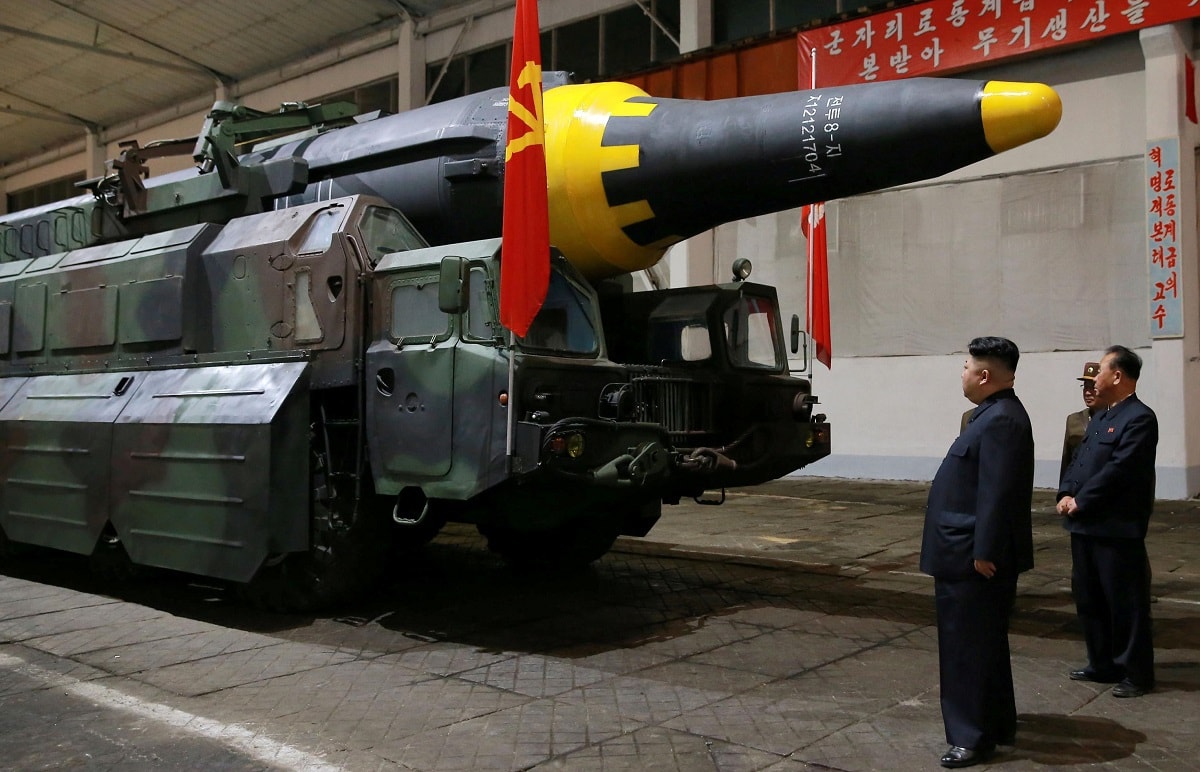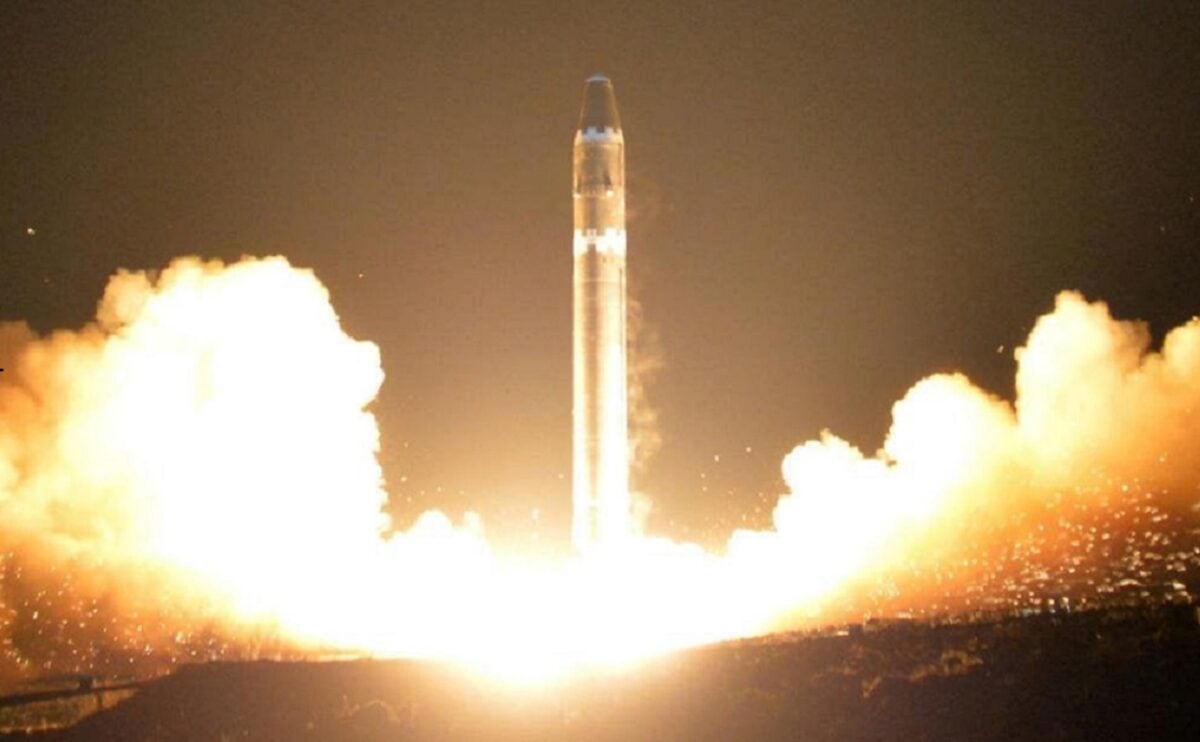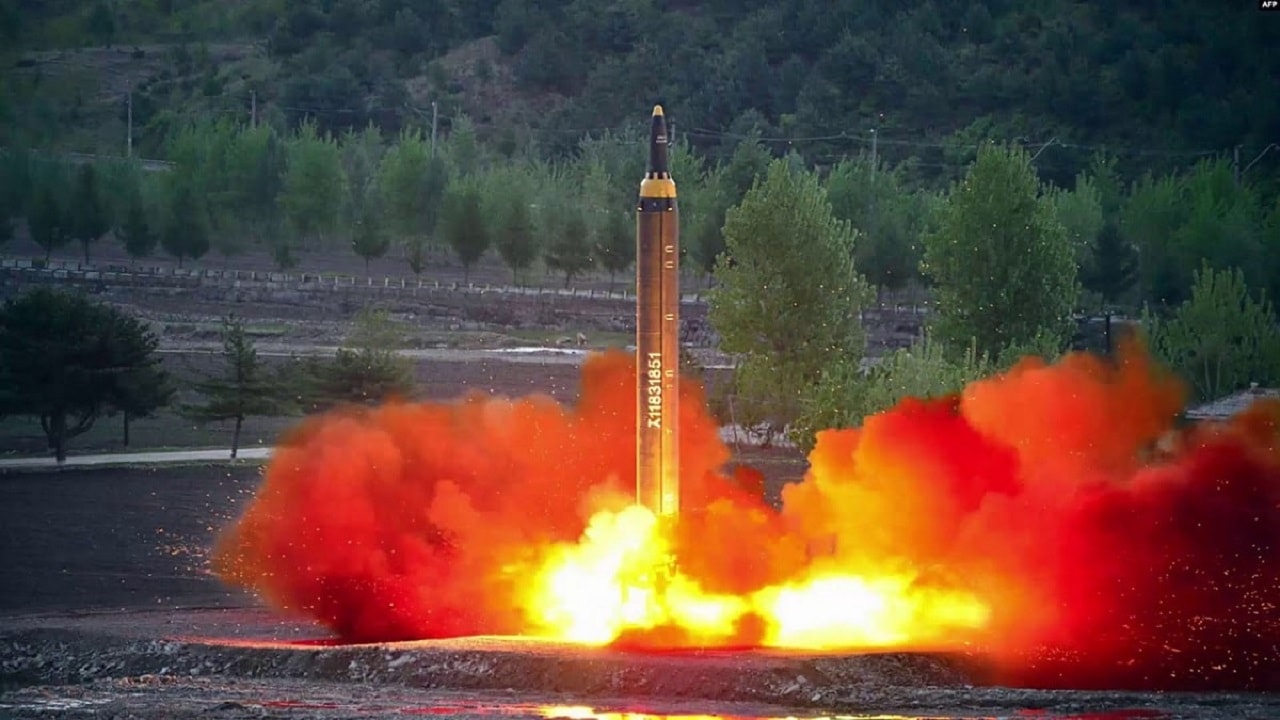North Korea’s Kim Jong-un won’t wait quietly for his turn as the center of international attention. On Sunday he shot off his seventh missile of the month, starting 2022 with a literal bang. South Korea’s Joint Chief of Staff figured the missile was of intermediate-range, the most powerful tested since 2017.
The test was noteworthy for another reason: South Korean President Moon Jae-in sharply criticized the North. Perhaps finally having lost patience with North Korea, he instructed Pyongyang to “stop raising tensions and pressure” and return to negotiations. He even said the latest test meant “that North Korea has come close to abandoning its moratorium,” Kim’s 2018 voluntary test suspension. Although the Democratic People’s Republic of Korea explicitly excluded intermediate-range ballistic missiles (IRBMs) from that pledge, none had been launched during that time.
The US Indo-Pacific Command criticized the test but noted that it posed no threat to America. With Washington convulsed over a possible war in Europe, little reaction is likely. Even this month’s earlier tests earned no more than a verbal complaint. State Department spokesman Ned Price emphasized that the Biden administration remained committed to negotiation.
Of possibly greater significance will be the reaction of China. The shot came shortly before the start of the Beijing Olympic Games. Although the state of the current bilateral relationship remains speculative, after a period of at best frigid contact from 2011 to 2017 China’s Xi Jinping rushed to make up for a lost time after the announcement of the first planned Trump-Kim summit. The People’s Republic of China likely has been helping the North with food and energy shipments. Moreover, rail traffic appears to have reopened between the two countries.
However, the PRC almost certainly doesn’t want its small neighbor to upstage the Olympics, already beset with difficulties, ranging from the COVID-19 pandemic to the US-led diplomatic boycott. So Kim may be rushing to finish his current tranche of tests before the competition’s start. Or Kim may have decided, given the current poor state of Washington-Beijing relations, that China is not likely to make him pay a price whenever he tests.
The most important question is Kim’s objective. Ewha University’s Leif-Eric Easily offered a medley of possible motives: aiding military modernization, boosting national pride, deterring attempted regime change, and extorting benefits to ensure good behavior. All are possible, but none explain the dramatic increase in testing this month.
Modernization is an ongoing process. At the margin, the fifth, sixth, and seventh shots don’t add much to the North’s self-image. Pyongyang has long established its ability to hit nearby targets, so the latest tests add little to its deterrent capabilities. Extortion is always a good assumption, but without engagement it is difficult for the DPRK to request let alone collect any tribute. Perhaps Kim plans to ask soon, but his most pliable potential partner, South Korea’s Moon, will soon be out of office. Moreover, the tests likely hurt the South’s ruling party, which has spent five years promoting détente, in the upcoming vote and the opposition, if victorious, likely will take a much tougher stance toward the North.
Closer to the truth might be the Asan Institute’s Cheon Seong-whun: Pyongyang’s “goal is to make the United States and its allies accept its nuclear arsenal as a fait accompli.” Believing that sanctions relief was unlikely, certainly in the near-term, Kim might have decided to switch to a long game.
He cut his country off from much of the world, ostensibly to battle COVID-19, but also enabling him to sharply limit foreign, and especially South Korean, influences. He went from hosting a K-Pop concert in 2018 to waging war on North Korean teenagers listening to K-Pop, which he apparently came to view as a threat to his regime. He cemented his government’s relationship with Beijing, assuring his regime’s economic survival despite having essentially sanctioned his own nation.
And he embarked upon a military build-up to provide both a robust deterrent and significant negotiating leverage. Last year he called creating nuclear weapons “the exploit of greatest significance in the history of the Korean nation.” He included a lengthy wish list of weapons supposedly under development. Last fall he said the DPRK required an “invincible military capability.” At the party plenum last month Kim announced that “The military environment of the Korean peninsula and the trend of the international situation getting instable day after day demand that bolstering the state defense capability be further powerfully propelled without a moment’s delay.”
Earlier this month he summoned the Politburo, which “instructed the field concerned to reconsider all the confidence-building measures previously and voluntarily taken by our state and rapidly examine the issue on resuming all actions which had been temporarily suspended,” meaning nuclear and ICBM tests. The ruling body also promised to “strengthen and develop without delay more powerful physical means to definitely overpower the daily intensifying hostile moves of the United States.”
About the same time the regime criticized new sanctions imposed by the Biden administration in response to short-range missile tests. Pyongyang threatened: “If the U.S. adopts such a confrontational stance, the DPRK will be forced to take stronger and certain reaction to it.” The latest tests kill the proverbial two birds with one stone—punished the Biden administration and improved the North’s military arsenal.
Estimates of Kim’s current nuclear weapons potential range up to about 65. However, he could grow the stockpile substantially. A study by the Rand Corporation and Asan Institute figured that by 2027 the DPRK could have some 200 nuclear weapons and hundreds of missiles. Those numbers would provide both a powerful deterrent, placing the North well within the second tier of nuclear powers, as well as sufficient bargaining chips for sanctions relief.
Kim might be prepared to stop short of that level, but maybe not. Of course, much could happen before then. The regime might implode, Kim might die, Beijing might pull its aid, influential elites might demand a policy reversal. All plausible, but the Kim dynasty has survived everything so far, including a botched war, mass starvation, and self-isolation. While by no means certain, the odds favor Kim being in power five, ten, and fifteen years from now.
Which highlights the importance of thinking seriously about how to live, even uneasily, with a nuclear North Korea, negotiating for arms control, to limit the size and reach of Pyongyang’s arsenal, and promoting a stable, peaceful future, in which the North’s transformation is possible if not likely. Policies obviously should be coordinated with South Korea and Japan.
It also will be vital to talk with Beijing, which will have substantial influence over the Korean peninsula’s future. China would prefer to keep a buffer state, though one less obstreperous. Almost certainly Beijing would oppose a unified Korea allied with America but might tolerate Korean reunification with a South Korean pledge of neutrality and withdrawal of US troops. If the Kim dynasty became unstable, Washington and Seoul might not oppose intervention by the PRC to prevent civil war and secure nuclear weapons. The potential scenarios are many and the likelihood of Washington getting the result that it wishes are small. However, diplomacy might result in a second-best solution that everyone can live with.

Image of Hwasong-12 IRBM. Image Credit: KCNA.

Hwasong-15 ICBM. Image: KCNA.
North Korean provocations are unwelcome at any time. But especially now. US policymakers are preparing for a potential war in Europe, debating an explicit defense guarantee for Taiwan, and threatening Iran should it fail to return to the nuclear deal that the Trump administration abandoned. Who wants to take on the possibility of confrontation and conflict in Northeast Asia?
The good news, in the short term, at least, is that Kim Jong-un doesn’t want war. The bad news is that he might have lost interest in diplomacy while planning a long-term arms build-up. No doubt, at some point he will return to the negotiating table. However, by then his demands might swamp those made only a few years ago.
A 1945 Contributing Editor, Doug Bandow is a senior fellow at the Cato Institute, specializing in foreign policy and civil liberties. He worked as special assistant to President Ronald Reagan and editor of the political magazine Inquiry. He writes regularly for leading publications such as Fortune magazine, National Interest, the Wall Street Journal, and The Washington Times. Bandow speaks frequently at academic conferences, on college campuses, and to business groups. Bandow has been a regular commentator on ABC, CBS, NBC, CNN, Fox News, and MSNBC. He holds a JD from Stanford University.

